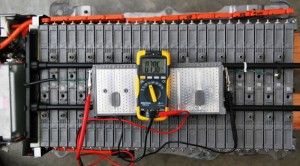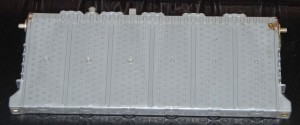Batteries may have different characteristics and specifications (specs), e.g.: Chemistry, Nominal (or Design) Capacity, Full Charge Capacity (FCC), Remaining Capacity, Nominal Voltage, Open Circuit Voltage (OCV), Internal Resistance, Self-Discharge Rate, Number of Recharge Cycles, Life Span, Internal Protective Valves or Electrical Switches, Mechanisms, Weight, Size, Output Power, Energy Density, Material of Enclosure, Type of External Connectors, etc. just few to mention. Our Glossary Page explains some of those terms.
The code on every battery contains information about manufacture date. It is not that hard to verify how “brand new” the batteries are.
Watch our video: Battery Modules Manufacture Date Scan: Original, Swapped or Rebuild?
Prismatic Batteries taken out from the hybrid car are not designed to work without physically being compressed from the sides. Their side panels may not withstand the pressure formed inside while charging. If you try to charge individual battery without it being properly handled – it will bulge and may even blow!
Batteries could have chemically hazardous substances inside them and normally should have relevant markings. Please always look for those if you intend to experiment.
Batteries in the hybrid car are normally assembled in series forming hazardous high voltage!
For example:
- Toyota Prius NHW-11 Battery Pack uses 38 prismatic plastic batteries. At 8.4 volts each that would present the high voltage inside the pack: 38 x 8.4 = 319.2 V!
- Toyota Toyota Prius NHW-20 and ZVW-30 Battery Pack uses 28 prismatic batteries. 28 x 8.4 = 235.2 V!
- Toyota Camry Hybrid uses 34 prismatic batteries. 34 x 8.4 = 285.6 V!
- Toyota Aqua (Prius C)Â uses 20 prismatic batteries. 34 x 8.4 = 168 V!
- Some Lexus Hybrid models use 40 prismatic batteries. 4o x 8.4 = 336 V!
Modern NiMH Batteries used in Toyota Prius, Camry and Lexus Hybrids are manufactured by Primearth EV Energy (PEVE).
Battery Specifications:
- Nominal Voltage: 7.2V
- Nominal Capacity: 6.5Ah
- Weight: 1.04kg
- Dimensions (mm): 19.6(W)—106(H)—285(L)

One government supported specialized Lab in USA runs standardized capacity tests on battery packs in controlled environment – i.e. from sample set of cars when those are new and on the same set of cars after 160000 miles. Here are some of their results clearly showing that batteries even when new could show capacity below designed and they degrade and loose their capacity even more with age and number of cycles:

Prismatic battery modules used in Prius NHW-11 are little bit different in design and size from those used in NHW-20, see photo below:

EV Energy web site as of December 2013 no longer displays information about the plastic prismatic battery for the second generation Prius. Newer modules from NHW-20 can be used to successfully re-assemble the NHW-11 packs.
Prius NHW-10 cylinder type batteries sometimes called “bamboo sticks”. Some of their characteristics are similar to Prismatic Batteries – e.g. nominal capacity and voltage.

